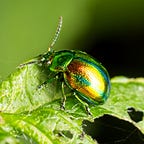Photographing Insects: October Shots
Some of the shots I took in October that have a story
Each month I collect some insect shots that have a special story. The number of insects is decreasing rapidly this time of the year, but I still managed to take some interesting photographs.
A red beetle
When walking along some bushes I noticed some red dot from the corner of my eye. Fortunately, I had my camera with me. After quite a bit of searching, I managed to locate this tiny beetle that was indeed very red. It is just a few millimeters in size. Because I had never seen such a red beetle before I assumed it would be rare. But that was not the case; it is actually rather common in the Netherlands. But it made for a very nice shot, I think.
No more insects
During this month the number of insects is rapidly decreasing. One day I decided to go visit a nature garden I had been to before, during summer. It used to be full of interesting insects. But this time it was very disappointing. There was nothing worth photographing.
But when I went outside it and walked back to my car I noticed a plant next to the path that still had yellow flowers. And on it, I noticed some insects. After close inspection, it turned out there were at least 10 different species on the plant, including this Stictopleurus Abutilon that I had not photographed before.
Never give up and always keep looking for something interesting.
Macro or micro
I sometimes try to attract night moths using a lamp and sheet. The night moth species are divided into macros, which are normally larger, and micros which are smaller. But this one is a bit confusing. In English, it is called a Pinion-streaked Snout, but in Dutch, it is a Gepijlde micro-uil. It is very small. But actually, it is a macro, which is called micro. Who came up with these names?
Spread your wings
When attracting night moths using a lamp and sheet, sometimes various beetles also appear. They are active at night and attracted by the light. This scarab beetle showed up. It is common in the Netherlands but you do not see it much during the day because it hides from the light, preferably in dung. When I tried to photograph it, it decided to fly away, so I was lucky to be able to take this shot. It is pretty amazing to see how its large wings unfold from underneath the covers.
Next: A Butterfly Garden
Previous: Winter is Coming
Mark Overmars is a dedicated insect photographer that loves to share and regularly publishes about his work and about photography in general. You can visit his website at www.insectphotography.org. Download his free insect photography book at www.insectphotography.org/book.
